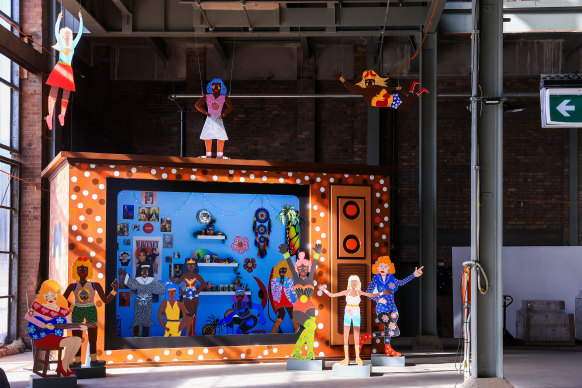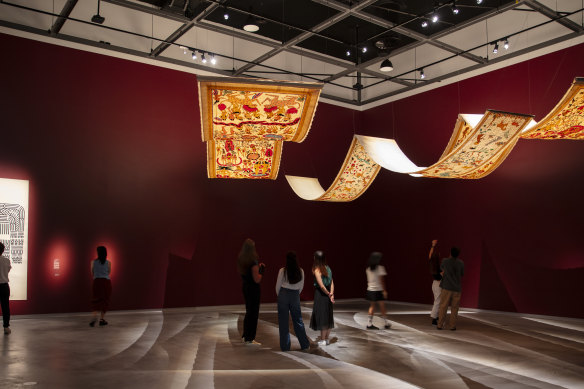
Cole was an activist who died of HIV, and was photographed many times by William Yang, whose chronicles of Sydney’s gay community and the ravages of the epidemic are our most vivid records of that period. Yang was happy to open his archive to the curators, who wanted to make a special feature of this vibrant, tragic era in Sydney’s social history.

Art collective VNS Matrix’s installation at White Bay.Credit: Getty
Another time capsule at White Bay features the cyberfeminist art collective VNS Matrix, who made their big splash in the early 1990s. Today, with the inexorable advance of digital technology, the VNS collages, photos and manifestos have a crude, retro feeling, but this only adds to their appeal. I never thought a burst of militant, feminist cyberpunk would induce twinges of nostalgia, but so be it. If you’re thinking this sounds like a lot of queer, Indigenous, PC works, I can’t disabuse you of that idea. Welcome to the echo chamber of contemporary art.
When I reflect on the White Bay display, many pieces seem joyous but slight, owing their impact to sheer scale. Whiskey’s cartoon figures, for instance, have become one of the longest-running comedy acts in Australian art. Each time I encounter them in a major show it’s a little harder to raise the requisite, gushing delight that seems to be the expected reaction.
Possibly the best gag in the Biennale is a series of ATMs painted by Doreen Chapman, of the Pilbara. There’s one or more at the entrance of every venue, a whimsical homage to the modern cash economy by an artist who has rarely ventured far from the Western Desert. Hopefully these ATMs won’t turn up in every major exhibition from now on, but it’s a possibility.
I suspect I’ll be less taken with White Bay on a second viewing, but it remains the must-see component of the Biennale. Upon visiting the Chau Chak Wing Museum at Sydney University and the Museum of Contemporary Art, we discover another of the curators’ heroes, namely Juan Davila, the Chilean émigré who has lived in Australia since 1974, cultivating a reputation as a fearless avant-gardist willing to trash every social and artistic orthodoxy.

Kaylene Whiskey’s installation at White Bay. Credit: Getty
Ever since his magnum opus Stupid as Painter was confiscated by the vice squad in 1982, Davila has been an icon of artistic offensiveness. He now tries to downplay that work at every opportunity, having developed a style that combines deliberately vulgar, ugly imagery with a technique that looks like vast areas of paint were applied in the most slapdash fashion to squeeze a large canvas out of a small idea.
There’s an essay to be written about vulgarity in Australian art as both a positive and negative force. In the former category, one might put artists such as Richard and Pat Larter, Davida Allen or Glenn Morgan. In the negative, Juan Davila and Norman Lindsay, who try too hard to shock and offend with quasi-pornographic kitsch. Am I being too unkind? Is this renowned slayer of sacred cows to be treated as a sacred cow himself?
Go see for yourself. There’s a whole room of Davila’s pictures at the Chau Chak Wing, but let’s just look at his largest work at the MCA, Enriqueta-Sieglinde Flees (2011). On a gigantic canvas coloured in with red-blue-purple smears, we see a naked, pregnant, Indigenous woman, arms and legs spread-eagled. She is flanked by two abstract ovoid shapes. It’s a disproportioned, sloppily brushed attempt to convey a sense of threat, as if the woman fears being raped or murdered. Please tell me why one should admire this painting.
If White Bay is the best of the Biennale, the adulation of Davila is probably the worst bit. Overall, there’s a remarkable amount of work that could be described, euphemistically, as “quirky”. Some of it veers dangerously close to the sort of thing one might find in a tourist shop. There’s also a special category of historical items, from William Strutt’s Black Thursday (1851), displayed anomalously at the MCA, to ’70s works by Bonita Ely, and even Rover Thomas’ Cyclone Tracy (1991) from the National Gallery of Australia, both on show at the AGNSW.

Mangala Bai Maravi’s installation at the Chau Chak Wing Museum.
It’s all part of a strand of historical revisionism that is allowed full rein in the wall labels and has already got the Biennale in trouble for some hasty digs at the Gallipoli campaign, which were consequently removed from the website. This is a topic that needs to be saved for another day, along with more in-depth discussion of other Biennale venues. There’s a lot more to be said about this ambitious exhibition, but as it runs for a further three months, it might be best to return under the rays of another sun.
The 24th Biennale of Sydney: Ten Thousand Suns is at the White Bay Power Station, Art Gallery of NSW, Chau Chak Wing Museum, Museum of Contemporary Art, UNSW Galleries, Artspace and Sydney Opera House until June 10.









 Add Category
Add Category